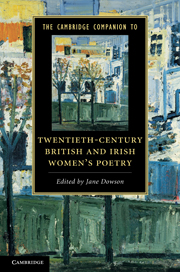Book contents
- Frontmatter
- 1 Introduction
- 2 Post/Modernist rhythms and voices: Edith Sitwell and Stevie Smith to Jo Shapcott and Selima Hill
- 3 Reframing women’s war poetry
- 4 Verbal and visual art in twentieth-century British women’s poetry
- 5 Towards a new confessionalism
- 6 The mid-Atlantic imagination: Mina Loy, Ruth Fainlight, Anne Stevenson, Anne Rouse and Eva Salzman
- 7 The Irish history wars and Irish women’s poetry: Eiléan Ní Chuilleanáin and Eavan Boland
- 8 Interculturalism: Imtiaz Dharker, Patience Agbabi, Jackie Kay and contemporary Irish poets
- 9 Post-pastoral perspectives on landscape and culture
- 10 Feminism’s experimental ‘work at the language-face’
- 11 Carol Ann Duffy, Medbh McGuckian and ruptures in the lines of communication
- Selected reading
- Index
4 - Verbal and visual art in twentieth-century British women’s poetry
Published online by Cambridge University Press: 28 May 2011
- Frontmatter
- 1 Introduction
- 2 Post/Modernist rhythms and voices: Edith Sitwell and Stevie Smith to Jo Shapcott and Selima Hill
- 3 Reframing women’s war poetry
- 4 Verbal and visual art in twentieth-century British women’s poetry
- 5 Towards a new confessionalism
- 6 The mid-Atlantic imagination: Mina Loy, Ruth Fainlight, Anne Stevenson, Anne Rouse and Eva Salzman
- 7 The Irish history wars and Irish women’s poetry: Eiléan Ní Chuilleanáin and Eavan Boland
- 8 Interculturalism: Imtiaz Dharker, Patience Agbabi, Jackie Kay and contemporary Irish poets
- 9 Post-pastoral perspectives on landscape and culture
- 10 Feminism’s experimental ‘work at the language-face’
- 11 Carol Ann Duffy, Medbh McGuckian and ruptures in the lines of communication
- Selected reading
- Index
Summary
This sketch / became a simile. . .
(Liz Lochhead )In the eponymous poem in Carol Ann Duffy’s 1985 collection Standing Female Nude, the female subject describes herself being painted. She imagines her future as an art object to be discussed and analysed in museums, and comments wryly on the gap between her world of Parisian prostitution and the bourgeois perspective of the man who paints her. The last withering put-down – ‘It does not look like me’ – signals a failure of representation; a school of painting often associated with heightened realism is rewritten as a process of appropriation and disfigurement. The poem both resists and underlines what, for many, is a truism of Western portrait painting. As John Berger has argued in Ways of Seeing:
According to usage and conventions which are at last being questioned but have by no means been overcome – men act and women appear. Men look at women. Women watch themselves being looked at . . . and are always depicted in a different way to men – because the ‘ideal’ spectator is always assumed to be male and the image of the women is designed to flatter him.
Berger’s thesis suggests that the way we read Titian’s Venus of Urbino (1538) or Vermeer’s The Milkmaid (c.1658) is less a subjective or contextual response than a product of highly codified social and sexual dynamics. The notion of a female portrait embodies how women have been, and continue to be, viewed and objectified by a male society. Berger’s argument has a particular relevance for ekphrastic poetry, verse which makes verbal portraits from visual ones. Although rarely identified as such, this poetic tradition is as gender-specific as its painterly counter-part. This chapter, drawing on visual theory, will explore how twentieth-century British female poets as diverse as Stevie Smith (1902–71), Lynette Roberts (1909–95) and Liz Lochhead (1947–) have reshaped the ekphrastic genre for their own ends.
- Type
- Chapter
- Information
- Publisher: Cambridge University PressPrint publication year: 2011
- 13
- Cited by



